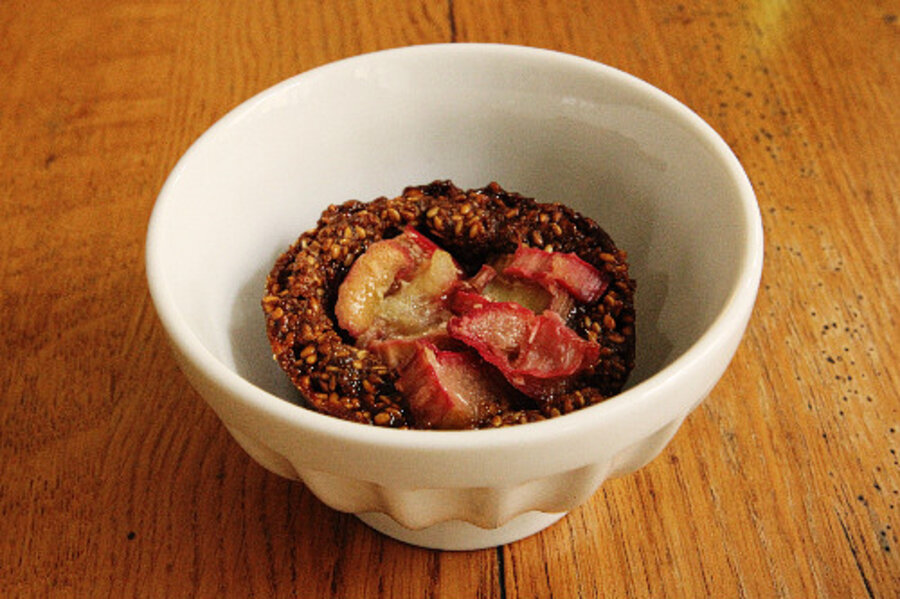To celebrate Chinese New Year, a study in red and rhubarb
Artist Hung Liu’s artistic production is a process of recollection – a symbolic excavation. Having weathered the re-education of artists vis-a-vis Mao’s Cultural Revolution and immigration to the U.S. in 1984, Hung Liu’s influences are richly transcultural. She is known as one of the very first Chinese artists to study within the US and has since received numerous accolades for her dynamic work. Starting from anonymous photographs (often of unnamed Chinese prostitutes), Liu’s portrayals pair elements of tradition with contemporary critique. Vividly, her use of color challenges her audiences’ emotive links to color. In an interview she gave in 1995, Hung Liu refers to her vibrant use of color, particularly red: “Red is an alarming color. We use red lights to warn people; to tell about danger and to use caution. In China, red is the color of the national flag. It is also the color of revolution; it suggests blood. Red also is used for celebration; it is festive and is used for such things as weddings, the Chinese New Year, and red banners. I like to work with layers of meaning.” (1)
Quite literally layered, "Yang, 2008," features a print of a prior work embedded in cast resin and superimposed with Liu’s signature use of historical Chinese motifs (here cherry blossoms) and thinned pigment dripped across the surface. Liu’s repetition of the dominant red background in the red of the woman’s crowning flowers and more intensely in her set lips, draws on the color’s innumerable associations. Pairing a recipe to this painting requires a taste both strong and lingering – a rhubarb tart tinged with the spice of ginger and cayenne. Like the wavering paint drips, the straight lines of the recipe’s fresh rhubarb stalks melt into stringy red and pink ribbons. The bittersweet nature of the rhubarb paired with the delicately burnt molasses and speckled sesame seed crust recalls her subject’s strength of character and altogether tragic displacement in time – an otherwise lost history uncovered and commemorated by Hung Liu.
In parallel to Liu’s use of skills steeped in traditional technique and her constant reintroduction of layered meaning to her work, the classic rhubarb tart is brought full circle to its own origins. The rhubarb pie of Western origin meets the plant’s Chinese heritage in its combination with a sesame and buckwheat crust. Stemming from the buckwheat family, rhubarb has been used for centuries as a medicinal plant to cure a wide variety of ailments. It is this curative quality that perhaps best links the recipe with this work as it compliments Hung Liu’s desire to create memorial sites for lost memories – both celebrating and mourning their subject.
(See next page for recipe)
Rhubarb tart with burnt molasses and sesame seed shells
Burnt molasses and sesame seed shells:
2 teaspoons butter
1 cup sesame seeds
2/3 cup brown sugar
2/3 cup buckwheat flakes
1/2 cup molasses
1 teaspoons cayenne
Begin by roasting the sesame seeds in a hot saucepan. They should crackle and pop. Stir quickly until they are browned and fragrant – not burnt. Turn down the heat to medium. Add butter, stirring until it melts. Mix in brown sugar, buckwheat, molasses and cayenne. Stir constantly as the mixture thickens – between 5-10 minutes. Spoon enough mixture into each cupcake form to roughly 1/3. When the mixture is cool enough to touch, yet still malleable, press along sides of the mold. Bake at 170 degrees C./ 338 degrees F. for no more than 10 minutes watching closely to see that the sides do not fall. The crust will harden fully at room temperature. Let cool completely before filling.
Rhubarb filling:
150 grams (about 2/3 cup) rhubarb, chopped
4 tablespoons caster sugar
3 tablespoons tapioca flour
3 tablespoons lemon juice
1 thumb ginger, finely chopped
Mix together in sauce pan and cook until thick. Pour into hardened shells.
Let set and enjoy!
Cassandra Edlefsen Lasch is a Berlin-based art historian and artist adviser active within international contemporary art production and project realization. Investigating collaboration is central to her work. This was a guest post as part of a Colour Project in collaboration with Megan Fizell, who deconstructs fine art into recipes at Feasting On Art.
To see the original post, click here.
--------------------------------------------------------------
The Christian Science Monitor has assembled a diverse group of food bloggers. Our guest bloggers are not employed or directed by The Monitor and the views expressed are the bloggers' own and they are responsible for the content of their blogs and their recipes. All readers are free to make ingredient substitutions to satisfy their dietary preferences, including not using wine (or substituting cooking wine) when a recipe calls for it. To contact us about a blogger, click here.






